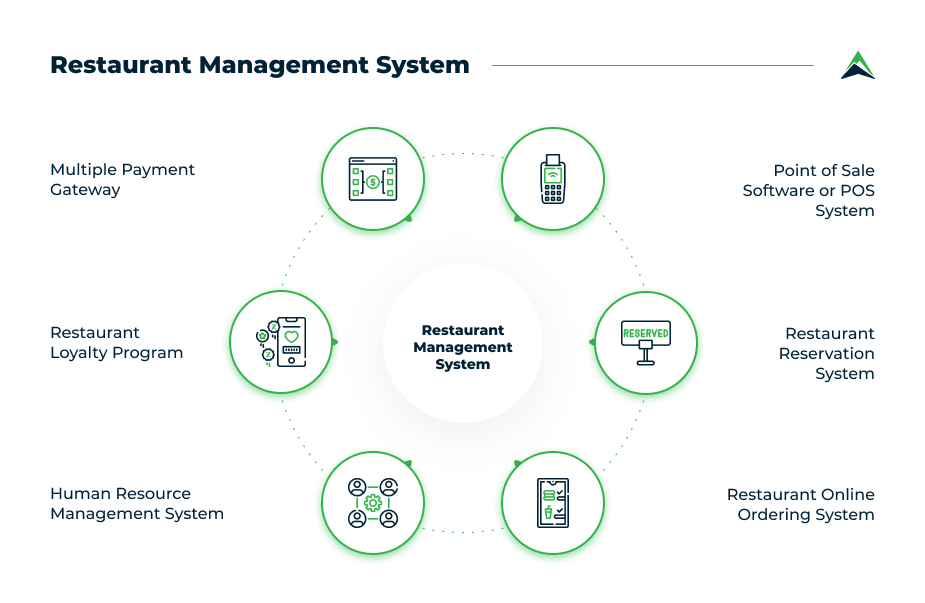The rapid transformation of the Food & Beverage sector is spurring the implementation of restaurant management software. The surveys indicate that the restaurant management systems market reached a value of $4.08 billion in 2021 and is predicted to grow at a 15.8% annual rate by 2030.
According to the recent State of Restaurant Tech report, 75% of restaurant owners plan to invest in apps for restaurant management in 2023 in order to boost business efficiency to battle rising food and labor costs.
In this blog post, we will list the various categories of restaurant management applications and delve into the fundamentals of developing restaurant software.
But before we dive in, let’s establish a precise definition of a restaurant management system and examine why its utilization simplifies and improves restaurant operations.
A closer look at restaurant management software
A restaurant management system (RMS) is an application built to automate various operational facets of a diner, bistro, cafe, fast-food outlet, or eatery. It aids owners and managers in the efficient execution of their daily duties, delivers better customer experience, and upgrades general business performance.
Restaurant technology solutions, like RMSs, are instrumental in enhancing efficiency, minimizing errors, elevating client satisfaction, and ultimately increasing profits. These tools provide the means to effectively automate the numerous facets of running a restaurant. The capabilities may vary based on the application provider and the requirements of a particular food and beverage company.
For example, an RMS may empower cafes, diners, and eateries to monitor reservations, assign seats, prevent overbooking, and make sure the available space was utilized effectively.
Other solutions facilitate shift scheduling, attendance monitoring, and performance appraisal. Certain systems even oversee payroll and tip distribution. Moreover, RMS tools adeptly handle bookings made via various channels, be it online or via phone, and successfully manage a waitlist for walk-in clients. This optimization guarantees swift table turnover and minimal wait times.
Workers can access visual dashboards with analytical insights pertaining to various business processes. This invaluable information aids in making well-informed decisions and optimizing operations.
Now that you have a solid understanding of what a restaurant management system is, we will list some of the fundamental characteristics of RMS tools. But first, let’s give a brief overview of their advantages.

Uncovering the pros of a restaurant management system
It’s no secret that digital restaurant management solutions can deliver significant business advantages. Here are some of their primary benefits:
Optimization
Restaurant management software optimizes various facets of operations, such as order fulfillment, supplies supervision, and table reservations.
Excellent service
By controlling table reservations and waitlists, you can provide a superior client experience by minimizing wait times and ensuring a smoother dining experience.
Avoiding inaccuracies
Integrated POS (Point of Sale) systems minimize inaccuracies, guaranteeing that customers receive the correct orders and bills.
Stock tracking
Restaurant software solutions facilitate the instant tracking of supplies, minimizing food wastage and ensuring optimal stock levels. This translates to cost savings and reduced losses.
Expense monitoring
Precisely monitor expenses, including labor costs, ingredient expenses, and other overheads. This empowers better cost control and budget optimization.
Menu updates
Effortlessly update menus, introduce seasonal items, or remove discontinued dishes. This adaptability keeps the menu fresh and appealing to visitors.
Analytics
Powerful reporting and analytical instruments offer valuable perspectives into sales trends, customer inclinations, and crucial data. These observations serve as the foundation for well-informed business choices.
Employee supervision
Software for restaurant management efficiently handles staff schedules, monitors work hours, and calculates payroll, simplifying HR responsibilities.
Customer loyalty programs
Many apps offer controls for establishing and administering loyalty programs, fostering customer retention and repeat visits.
Internet ordering and delivery
Modern RMS apps seamlessly integrate with online ordering platforms and processing systems, streamlining the delivery process.
Legal requirements
Provide compliance with health, safety, and taxing regulations. The processes are automated to eliminate the risk of non-compliance.
Security
These applications safeguard customer details and payment information with secure payment processing solutions, minimizing the risk of data breaches.
Scalability
As your business expands, the software can scale accordingly, accommodating more requests, tables, and staff.
Marketing and promotions
Utilize customer data and insights to execute targeted marketing campaigns and promotions, increasing client engagement and sales.
Customer feedback
Collect and analyze customer feedback to pinpoint areas for improvement and enhance overall client satisfaction.
Time savings
Automation of tasks and reduction of manual entry liberates staff to concentrate on delivering exceptional service and enhancing other aspects of the operations.
RMS software is an invaluable resource for owners and operators looking for ways to improve restaurant management. Not only does it boost efficiency, cost-effectiveness, and service quality but also equips companies the tools to remain competitive in a dynamic industry. The benefits of a restaurant management system include enhanced adaptability to shifting client preferences and market trends.